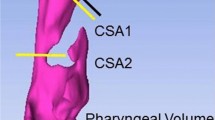Abstract
The aim of this study was to determine the associated factors affecting the outcome of uvulopharyngopalatoplasty (UPPP) in patients with severe obstructive sleep apnea hypopnea syndrome (OSAHS), and to investigate whether cephalometric measurements were predictive of the therapeutic response to UPPP in patients with severe OSAHS. We retrospectively studied 51 consecutive patients who underwent revised UPPP with uvula preservation (H-UPPP), or Z-palatopharyngoplasty (ZPPP) for severe OSAHS [apnea–hypopnea index (AHI) >30]. All patients were evaluated using physical examination, Epworth Sleepiness Scale (ESS), cephalometry, and nocturnal polysomnography (PSG) before surgery and at 6–12 months after surgery. Based on the success criteria defined as an AHI of <20 and a decrease >50 %, the overall success rate was 45.1 %. The preoperative distance from the posterior border of the uvula to the middle pharyngeal wall (U-MPW) was significantly longer in the responder group than in the nonresponder group, when considering the whole group or the H-UPPP group alone. Among all study subjects, U-MPW and change in body mass index (△BMI) were the significant predictors of surgical success. U-MPW was the key predictor for H-UPPP surgical success, whereas mandibular plane angle (MPA) and Friedman stage were the key predictors for ZPPP surgical success. In conclusion, U-MPW was a significant predictor of UPPP surgical success. Patients with U-MPW >10 mm who are unwilling to receive nasal continuous positive airway pressure (CPAP) therapy might be suitable candidates for UPPP surgery.

Similar content being viewed by others
References
Lin HS, Zuliani G, Amjad EH, Prasad AS, Badr MS, Pan CJG, Rowley JA (2007) Treatment compliance in patients lost to follow-up after polysomnography. Otolaryngol Head Neck Surg 136:236
Haniffa M, Lasserson T, Smith I (2004) Interventions to improve compliance with continuous positive airway pressure for obstructive sleep apnoea. Cochrane Db Syst Rev 18(4):CD003531
Fujita S, Conway W, Zorick F, Roth T (1981) Surgical correction of anatomic azbnormalities in obstructive sleep apnea syndrome: uvulopalatopharyngoplasty. Otolaryngol Head Neck Surg 89:923–934
Sher AE, Schechtman KB, Piccirillo JF (1996) The efficacy of surgical modifications of the upper airway in adults with obstructive sleep apnea syndrome. Sleep 19:156–177
Friedman M, Ibrahim H, Joseph NJ (2004) Staging of obstructive sleep apnea/hypopnea syndrome: a guide to appropriate treatment. Laryngoscope 114:454–459
Friedman M, Ibrahim HZ, Vidyasagar R, Pomeranz J, Joseph NJ (2004) Z-palatoplasty (ZPP): a technique for patients without tonsils. Otolaryngology-Head and Neck Surg 131:89–100
Han D, Ye J, Lin Z, Wang J, Zhang Y (2005) Revised uvulopalatopharyngoplasty with uvula preservation and its clinical study. ORL 67:213–219
Yi HL, Yin SK, Zhang YJ, Chen B, Lu WY, Sun XQ, Cao ZY, Wu HM, Guan J (2009) Z-palatopharyngoplasty for obstructive sleep apnea/hypopnea syndrome. Otolaryngol Head Neck Surg 140:640–645. doi:10.1016/j.otohns.2009.02.002
Xiong YP, Yi HL, Yin SK, Meng LL, Tang XL, Guan J, Luo HP, Zhang WT, Chen B (2011) Predictors of surgical outcomes of uvulopalatopharyngoplasty for obstructive sleep apnea hypopnea syndrome. Otolaryngol Head Neck Surg 145:1049–1054. doi:10.1177/0194599811420811
Hudgel D, Harasick T, Katz R, Witt W, Abelson T (1991) Uvulopalatopharyngoplasty in obstructive apnea: value of preoperative localization of site of upper airway narrowing during sleep. Am Rev Respir Dis 143:942–946
Millman RP (2000) Simple Predictors of uvulopalatopharyngoplasty outcome in the treatment of obstructive sleep apnea. Chest 118:1025–1030. doi:10.1378/chest.118.4.1025
Doghramji K, Jabourian ZH, Pilla M, Farole A, Lindholm RN (1995) Predictors of outcome for uvulopalatopharyngoplasty. Laryngoscope 105:311–314
Friedman M, Ibrahim HZ, Vidyasagar R, Pomeranz J, Joseph NJ (2004) Z-palatoplasty (ZPP): a technique for patients without tonsils. Otolaryngol Head Neck Surg 131:89–100
Ricketts RM (1968) Esthetics, environment, and the law of lip relation. Am J Orthod 54:272–289
Senior BA, Rosenthal L, Lumley A, Gerhardstein R, Day R (2000) Efficacy of uvulopalatopharyngoplasty in unselected patients with mild obstructive sleep apnea. Otolaryngol Head Neck Surg 123(3):179–182
Caldarelli DD, Cartwright R, Lilie JK (1986) Severity of sleep apnea as a predictor of successful treatment by palatopharyngoplasty. Laryngoscope 96:945–947
Li HY, Wang PC, Lee LA, Chen NH, Fang TJ (2006) Prediction of uvulopalatopharyngoplasty outcome: anatomy-based staging system versus severity-based staging system. Sleep 29:1537–1541
Shepard JW Jr, Olsen KD (1990) Uvulopalatopharyngoplasty for treatment of obstructive sleep apnea. Mayo Clin Proc 65:1260–1267
Langin T, Pépin JL, Pendlebury S, Baranton-Cantin H, Ferretti G, Reyt E, Lévy P (1998) Upper airway changes in snorers and mild sleep apnea sufferers after uvulopalatopharyngoplasty (UPPP). Chest 113:1595–1603
Li HY, Li KK, Chen NH, Wang CJ, Liao YF, Wang PC (2005) Three-dimensional computed tomography and polysomnography findings after extended uvulopalatal flap surgery for obstructive sleep apnea. Am J Otolaryngol 26:7–11
Shepard JW Jr, Thawley SE (1989) Evaluation of the upper airway by computerized tomography in patients undergoing uvulopalatopharyngoplasty for obstructive sleep apnea. Am J Respir Crit Care Med 140:711
Woodson B, Conley S, Dohse A, Feroah T, Sewall S, Fujita S (1997) Posterior cephalometric radiographic analysis in obstructive sleep apnea. Ann Otol Rhinol Laryngol 106:310–313
Will MJ, Esther MS, Ramirez SG (1995) A comparison of cephalometric analysis with ethnicity in obstructive sleep apnea syndrome. South Med J 88:S79
Chang ET, Shiao GM (2008) Craniofacial abnormalities in Chinese patients with obstructive and positional sleep apnea. Sleep Med 9:403–410
Johansson K, Neovius M, Lagerros YT, Harlid R, Rössner S, Granath F, Hemmingsson E (2009) Effect of a very low energy diet on moderate and severe obstructive sleep apnoea in obese men: a randomised controlled trial. BMJ 339:b4609
Sutherland K, Lee RWW, Phillips CL, Dungan G, Yee BJ, Magnussen JS, Grunstein RR, Cistulli PA (2011) Effect of weight loss on upper airway size and facial fat in men with obstructive sleep apnoea. Thorax 66:797–803
Acknowledgments
Source of funding: program for advancing front technology of Shanghai Shenkan Center (SHDC12010209).
Conflict of interest
None.
Author information
Authors and Affiliations
Corresponding authors
Rights and permissions
About this article
Cite this article
Liu, S.R., Yi, H.L., Yin, S.K. et al. Associated predictors of therapeutic response to uvulopharyngopalatoplasty for severe obstructive sleep apnea hypopnea syndrome. Eur Arch Otorhinolaryngol 270, 1411–1417 (2013). https://doi.org/10.1007/s00405-013-2404-5
Received:
Accepted:
Published:
Issue Date:
DOI: https://doi.org/10.1007/s00405-013-2404-5




